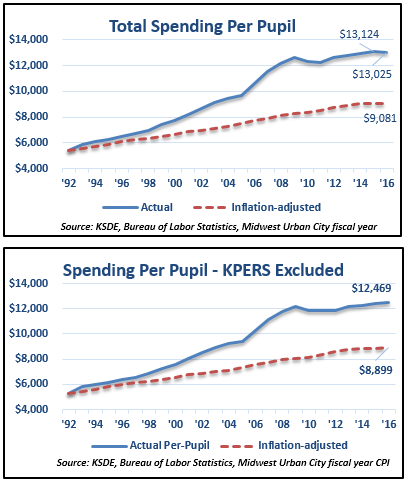Kansas school officials and teacher unions came out in strong support on Wednesday for House Bill 2270, a proposed new school funding formula that would cost taxpayers $965 million over a 4-year phase in. Some supporters expressed concern that the big price tag wasn’t enough but said the plan was a good starting point.
Legislators terminated the old formula in 2015 and have to create a new one by June 30 before the temporary block grant system expires; complicating matters further, the Kansas Supreme Court ruling on whether funding under the old formula meets the constitutional test of being adequate (enough) is expected very soon. Creating a formula that meets the Supreme Court test of adequacy is of the utmost importance but HB 2270 bizarrely makes no attempt to do.
Representative Melissa Rooker, who co-authored the bill with Senator Laura Kelly, confirms that her proposal makes no attempt to calculate or define what the Legislature deems to be constitutionally adequate. It’s not even a new school funding formula but, as Rep. Rooker explained, a modification of the old formula (but with much higher costs).
The Kansas Supreme Court says adequacy of funding “…is met when the public education financing system provided by the legislature for grades K-12—through structure and implementation—is reasonably calculated to have all Kansas public education students meet or exceed…” the Rose standards.
There was little, if anything, ‘reasonably calculated’ about the old formula or there was no focus on outcomes approaching specific goals. Indeed, the Legislature was repeatedly criticized in the Montoy and Gannon proceedings for having no rational basis for its funding decisions. Base state aid, weightings and even eligibility for equity funding were simply determined by picking numbers for which enough votes can be obtained.
Kansas Policy Institute testified in opposition to HB 2270, citing the above constitutional issue as well as the plan’s failure to hold districts accountable for improved outcomes and efficient spending of taxpayer money. Our full testimony can be read here.
Funding is already higher than schools need
Funding under the old formula was based a 2001 cost study by Augenblick & Myers but those calculations are now invalid. The Supreme Court instructed the lower court that they used the wrong test when relying upon that cost study, saying it was “…more akin to estimates…” than any certainties. The Gannon Supreme Court had the benefit of knowing that A&M deliberately deviated from their own methodology and produced inflated results, thanks to a 2009 legal analysis of Montoy written by then-KPI scholar and current Supreme Court Justice Caleb Stegall.
Per-pupil funding set another  record last year even without counting any KPERS retirement money and is at least 40 percent higher than if funding had been increased for inflation over the life of the old system. For perspective, had non-KPERS funding been increased for inflation since 1992, it would have been $1.6 billion less last year.
record last year even without counting any KPERS retirement money and is at least 40 percent higher than if funding had been increased for inflation over the life of the old system. For perspective, had non-KPERS funding been increased for inflation since 1992, it would have been $1.6 billion less last year.
Every efficiency audit has found schools districts to be spending more than necessary to provide certain services. Districts also acknowledge that some purchases cost more than necessary but oppose statewide purchasing plans to save money because they want to spend more to buy locally. But regardless of rationale, every such action is a conscious choice to divert discretionary money from Instruction; school funding is supposed to education students, not be diverted for other purposes.
Districts are also very inefficiently organized. The vast majority of the 286 districts maintain their own systems for accounting, payroll, IT, transportation, purchasing, HR, food service, maintenance and other functions. Those services could be provided through regional service centers at much lower costs and allow the savings to be used for Instruction; citizens overwhelmingly favor this concept but school officials and unions strongly oppose it.
Most school districts haven’t even spent all of the state and local tax dollars received in prior years. Operating carryover cash reserves (not counting capital, federal or debt service funds) totaled $468 million in 2005 but have since ballooned to $911 million; the $443 million difference represents taxpayer money collected but not spent. Reports for each district are available here on KansasOpenGov.org.
Several other proposals for a new school funding formula are being entertained by the House but Senate President Susan Wagle won’t allow discussions to begin in the upper chamber; she is reportedly holding off until she gets votes to reduce school funding reduced by 5 percent this year.




